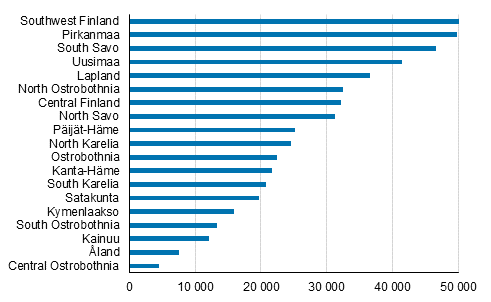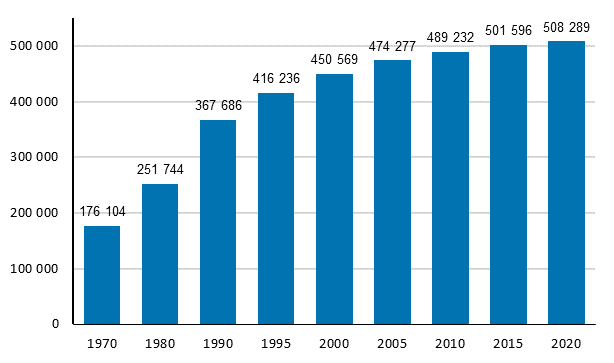Free-time Residences 2020
Kuopio had the highest number of free-time residences in 2020
According to Statistics Finland, there were over half a million free-time residences in Finland in 2020. At the same time, Kuopio was the biggest municipality in Finland by its number of free-time residences. Mikkeli was the second biggest municipality measured by the number of free-time residences in 2020. Both Kuopio and Mikkeli have more than 10,000 free-time residences.
Table 1. Municipalities with highest number of free-time residences in 2020
| Regional Division based on Municipalities on 1 Jan. 2021 | Number of free-time residences | |
| 1. | Kuopio | 10 507 |
| 2. | Mikkeli | 10 345 |
| 3. | Parainen | 9 665 |
| 4. | Savonlinna | 8 765 |
| 5. | Hämeenlinna | 8 636 |
| 6. | Lohja | 8 255 |
| 7. | Kuusamo | 7 518 |
| 8. | Kouvola | 7 477 |
| 9. | Raasepori | 6 848 |
| 10. | Salo | 6 455 |
| 11. | Pori | 5 141 |
| 12. | Naantali | 4 946 |
| 13. | Kemiönsaari | 4 889 |
| 14. | Mäntyharju | 4 791 |
| 15. | Kangasala | 4 506 |
Southwest Finland and Pirkanmaa were the regions with the highest number of free-time residences in 2020, around 50,000 free time residences in both regions. The regions of Central Ostrobothnia (4,500 free time residences) and Åland (7,500 free time residences) had the lowest numbers of free-time residences.
Figure 1. Number of free-time residences by region in 2020

The density of free-time residences in the municipality can also be described by comparing their number with that of permanently occupied dwellings. Then the municipalities richest in free-time residences were places that had a relatively low number of population and a high number of free-time residences. At the end of 2020, altogether 63 municipalities had more free-time residences than permanently occupied dwellings. Such municipalities were Pargas, Kuusamo, Kimitoön and Mäntyharju. As the number of permanent residents decreases, the number of free-time residences may become emphasised in ever more municipalities.
Figure 2. Municipalities with more free-time residences than occupied dwellings in 2020 (those with the highest number of free-time residences)

Stock of free-time residences grew most in the 1980s
The number of free-time residences grew fastest in the 1980s. In 1990, there were 368,000 free-time residences, which was 46 per cent more than in 1980. From 1970 to 1980, the increase was 75,600, or 43 per cent. Since 2020, the stock of free-time residences also includes rental holiday cottages and the detached houses that have been reported to be in leisure-time use are no longer included as free-time residential buildings.
Figure 3. Number of free-time residences in 1970 to 2020

Altogether 2,000 new free-time residences completed per year
Over 4,000 new free-time residential buildings have been completed per year in the 2000s. Nowadays they are completed less and less free-time residences per year. For example only around 2,000 new free-time residential buildings were completed in 2020. In the 2000s, the highest numbers of free-time residential buildings have been completed in general in Lapland, South-Savo and Southwest Finland, where their number has grown by around 400–500 per year.
Average size of free-time residences 49 square metres
New free-time residences are larger in floor area than before. The average floor area of free-time residences built in the 2010s was 72 square metres and the median 64 square metres. The average floor area of free-time residences built in 2000 to 2009 was 67 square metres and the median 57 square metres. The average floor of all free-time residences was 49 square metres in 2020. The known square metres of free-time residences are included in the average floor size (the floor area of around 13,000 free-time residences is unknown). Large free-time residences and buildings used as leisure-time housing increased the average size to some extent, as the median floor area of all free-time residences was 40 square metres. Thus, one-half of free-time residences still have a floor area of 40 square metres or less. The share of large free-time residences with a floor area of at least 60 square metres was 25 per cent of all free-time residences in 2020. In 1970, the share of such large free-time residences in the stock of free-time residences was 15 per cent.
Table 2. Free-time residences by floor area in 2020
| Floor area, m2 | Number of free-time residences | % |
| Free-time residences, total | 508 289 | 100,0 |
| – 19 | 49 694 | 9,8 |
| 20 – 39 | 182 571 | 35,9 |
| 40 – 59 | 134 989 | 26,6 |
| 60 – 79 | 64 054 | 12,6 |
| 80 – 99 | 31 476 | 6,2 |
| 100 – | 32 143 | 6,3 |
| Unknown | 13 362 | 2,6 |
| Average floor space | 49 | . |
| Median floor space | 40 | . |
Over 780,000 Finns belong to a household-dwelling unit with a free-time residence
Of all free-time residences, 422,000 were owned by private persons. Around 85,800 free-time residences were owned by heirs, companies, communities or foreigners. In all, almost 782,300 persons belonged to a household-dwelling unit that owned a free-time residence. In many municipalities, summer residents double the population of the municipality in summer.
Free-time residences are usually located near the owner’s permanent residence. In total, 64 per cent of free-time residence owners had a free-time residence in their region of residence. More than 90 per cent of free-time residence owners in Åland and Lapland owned a free-time residence in the region of residence. By contrast, the free-time residences of persons residing in Uusimaa were mainly located in some other region. Only 28 per cent of Uusimaa residents owned free-time residences in Uusimaa. One-third of all free-time residence owners had a free-time residence in their municipality of domicile.
Average age of free-time residence owners is 63 years
The average age of the owners of new free-time residences completed in 2020 was 55 years, while the average age of all owners of free-time residences was 63 years in 2020. Around 24,000, or only seven per cent of all free-time residence owners were aged under 40.
Of all free-time residences, nearly 40 per cent were owned by a household-dwelling units of two adults and 11 per cent by households with children aged under 18. Fifteen per cent of free-time residences were owned by single-person households and 17 per cent by heirs, companies, communities or the owner was unknown. Almost 60 per cent of the owners of free-time residences lived in detached or semi-detached houses. Twenty-eight per cent of owners of free-time residences live in blocks of flats. Eleven per cent of free-time residence owners head out to their free-time residence from terraced houses.
Source: Buildings and Free-time Residences, Statistics Finland
Inquiries: Mika Ronkainen 029 551 3425, Anu Rämö 029 551 3450, info@stat.fi
Head of Department in charge: Hannele Orjala
Updated 27.5.2021
Official Statistics of Finland (OSF):
Buildings and free-time residences [e-publication].
ISSN=1798-6796. 2020,
Free-time Residences 2020
. Helsinki: Statistics Finland [referred: 26.12.2025].
Access method: http://stat.fi/til/rakke/2020/rakke_2020_2021-05-27_kat_001_en.html

